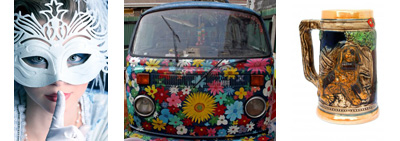
There is art and then there is stuff. Art is copyrightable. Stuff is not. The Copyright Act refers to stuff people use (rather than just look at, listen to, or read) as a “useful article.” Useful articles are generally not copyrightable. The design of clothing, furniture, automobiles, cell phones, speakers, and anything else which is useful (and typically not considered “art”) is not entitled to copyright protection.
In order to protect the artistic design of a useful article you need to get a design patent (in the United States) or a design registration (available in certain foreign jurisdictions). Design patents, however, must be both novel and non-obvious which is often a difficult standard for artistic designs. In addition, design patents cost a lot more to get and only last fourteen (14) years (unlike copyrights which seem to last forever).
So are there exceptions which allow useful articles some protection under the Copyright Act? Of course—Congress makes the law, but lawyers make exceptions.
The Copyright Act defines useful article in 17 USC § 101:
“A “useful article” is an article having an intrinsic utilitarian function that is not merely to portray the appearance of the article or to convey information. An article that is normally a part of a useful article is considered a “useful article.”
Luckily there is a large and nebulous exception to this simple rule. Sometimes a portion, but not the whole useful article is copyrightable. Stuff sometimes contains art. The key is whether the art can be separated from the stuff. The Copyright Act explains this concept in 17 USC § 101:
“the design of a useful article, as defined in this section, shall be considered a pictorial, graphic, or sculptural work only if, and only to the extent that, such design incorporates pictorial, graphic, or sculptural features that can be identified separately from, and are capable of existing independently of, the utilitarian aspects of the article.”
In order for the art to be separate from the stuff, courts have held that there must either be a physical separation or a conceptual separation.
A physical separation basically means you can remove the art with a hacksaw. The seminal case regarding physical separation is the U.S. Supreme Court case, Mazer V. Stein, 347 U. S. 201 (1954). In Mazer, a previously copyrighted statuette was used as the base of a lamp. Because the art could be physically separated from the lamp and still retain its artistic charm, the Supreme Court held that the statuette was entitled to copyright protection even when used as a lamp base.
A conceptual separation is a little more vague. In order for art to be conceptually separated from stuff, the art must be able to stand on its own as a work of art and the stuff must still be useful without the art. A wild painting on the side of a van down by the river is a good example of art that can be conceptually separated from the van (but cannot be separated with a hacksaw).
What about toys? Most courts have held that a toy does not meet the Copyright Act’s definition of a “useful article” which defines useful article as “an article having an intrinsic utilitarian function that is not merely to portray the appearance of the article” – a toy train’s purpose is to portray the appearance of a real train and therefore is specifically excluded from the Act’s definition of “useful article.”
What about clothes? Courts have held that designs placed on clothes are copyrightable, but that the shape and cut of the clothing are not entitled to copyright protection.
What about costumes? Courts have held that costumes, like clothes, are generally not copyrightable.
What about furniture? Courts have held that the shape of a couch is not copyrightable, but certain designs and sculpted features which are part of furniture may be entitled to copyright protection.
What about this other widget? Can you separate the art from the stuff? Send in a copyright application and hope for the best.
